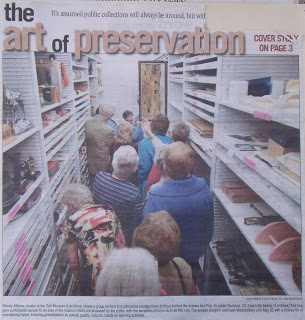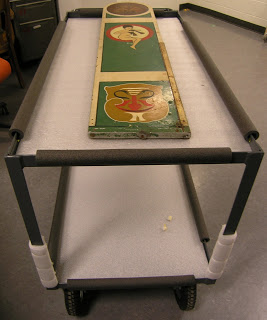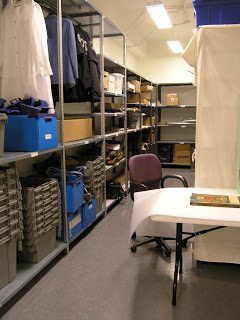Behind-the-Scenes Collections Tour
During my senior's program recently, I went on a collections 101 tour at the museum. We do public tours of the collections several times a year and I have been meaning to blog about this for a while because going behind the scenes is so neat. Today Nicole Hembroff, the collections assistant, agreed to help me out with a virtual recreation of the tour for the blog.
The staff on the collections team care for over 15,000 objects and it's their attention to detail that keeps the objects safe. The museum is climate controlled which means controlling the temperature, humidity, light, and air quality. The collections staff monitors the temperature and humidity using a special machine called a hygrothermograph. Special materials used during storage and display of the objects, such as the ethafoam lining for the shelves, the boxes some objects are stored in, and the acid-free tissue, are all made of safe materials that won't harm the objects. Even the compact storage shelving is designed to protect the artifacts during a flood, fire or earthquake.
The staff and volunteers who work in the collections area are highly trained in caring for the objects - this includes both providing the correct storage facility and also handling the objects correctly. Moving an object is one of the riskiest things that can happen to an object so the staff and volunteers work very carefully, wearing cotton gloves, and often working in teams, to make sure that the objects safely make it to their next destination. Even our elevator at the museum is specially designed with objects in mind. The next time you ride on it notice how slow the elevator moves, and how gently it reaches each floor, this keeps the elevator from jarring objects that might be traveling on carts to and from the exhibit space.
When visitors come behind the scenes in the collections they are asked not to touch the objects. It sounds really simple but even as a staff person who knows better I am so often tempted to touch the objects. I'm also suddenly so self conscious of how much I like to talk with my hands flying around, and how often I like to lean on things. Personally, I have to walk around with my hands clasped behind my back or in my pockets to keep from reaching out and pointing at, or touching, some of the things in storage and to remind myself not to lean up against a shelf where I could bump into an object.
The first thing you see when you go into the collections area is the acquisitions room. Every item that comes into the collection gets its own unique number. The items are reviewed by an acquisitions committee which considers a variety of factors before formally accepting a donation into the collection. The museum has a collections policy that outlines the criteria for accessions. This criteria includes, but is not limited to, the story about the objects, and the relevance to the mission of the museum (the human history of southwest Alberta).
The second space you see when you walk into the collections area is the large item storage.
Other large objects are stored like this:
Another area that interests me is the clothing storage. Some items are stored on specially created hangers with padding to keep the shape of the garment. These hangers are made by some of our volunteers. Other clothes are stored "flat," but when you look inside the boxes you'll see that they are stuffed with tissue to maintain the shape of the garment. This prevents stress on the seams that could cause damage over time.
The majority of the objects are kept in compact storage. They are organised by the category of object. The categories generally refer to the use of the objects - for example the photo below is of communications objects such as cameras and radios.
Finally, textiles such as tablecloths are stored on mylar wrapped cardboard tubes. The textile is interlayered with acid free tissue and wrapped around the tube before it is protected by a final layer of muslin fabric. Cool eh?
With all of these storage systems and so many artifacts one can imagine how difficult it would be to find anything without some type of organizational system. Luckily, we have one of those too! the unique identifier assigned to each object is tied to a catalogue record stored in a computer database which contains information on everything from the artifact name, to its history, to where it is stored and much more.
If you are interested in going on a tour of the collections area watch the programming listings on our website, or look for our printed calendar of events. We'll offer tours featuring hand made objects during the member's sale at the end of November and the
senior's
program will also have a collections tour in the fall. If you have an object that you are interested in donating please call Kevin McLean at 403-320-4064.









